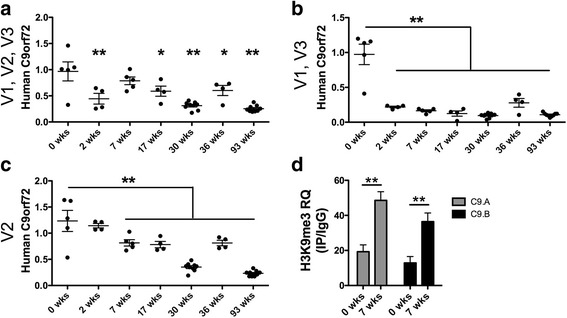Fig. 1.

C9ORF72 transcription decreases while a repressive histone methylation mark increases in the brain of C9-BAC mice during the first post-natal weeks. Values of human C9ORF72 in the BAC mouse cortex, normalized to the average of GAPDH and 18S, are shown for primers amplifying transcript variants V1, V2, V3 (a); V1, V3 (b) and V2 (c). Age groups are indicated on the x-axis in weeks (wks). Mean and standard error of the mean (SEM) are indicated by long and short bars respectively. For each primer set, a one-way analysis of variance was performed (p < 0.001). Bonferroni’s multiple comparison test was performed between neonatal (0wks) and the rest of the age groups, significance is indicated by p < 0.05 * and p < 0.01 **. H3K9me3 levels were assessed by chromatin immunoprecipitation in brain tissues from 0 to 7 week-old C9-BAC mice (n = 5). Two different primer sets were used: C9.A and C9.B amplifying regions within the human C9ORF72 promoter. Relative enrichment of H3K9me3 was calculated by real-time PCR amplification of immunoprecipitants (IP) relative to inputs and an IgG negative control IP, p < 0.01 ** (d)
